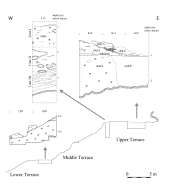Hélène Valladas, Norbert Mercier, Israel Hershkovitz, Yossi Zaidner, Alexander Tsatskin, Reuven Yeshurun, Laurence Vialettes, Jean-Louis Joron, Jean-Louis Reyss, Mina Weinstein-Evron
Source - http://www.sciencedirect.com/science/article/pii/S0047248413001668
Journal of Human Evolution
Abstract
The transition from the Lower to the Middle Paleolithic in the Levant is a crucial event in human evolution, since it may involve the arrival of a new human population. In the current study, we present thermoluminescence (TL) dates obtained from 32 burnt flints retrieved from the late Lower Paleolithic (Acheulo-Yabrudian) and Early Middle Paleolithic (Mousterian) layers of Misliya Cave, Mount Carmel, Israel. Early Middle Paleolithic industries rich in Levallois and laminar products were assigned mean ages ranging from ∼250 to ∼160 ka (thousands of years ago), suggesting a production of this industry during MIS 7 and the early part of MIS 6. The mean ages obtained for the samples associated with the Acheulo-Yabrudian (strengthened by an isochron analysis) indicate a production of this cultural complex ∼250 ka ago, at the end of MIS 8. According to the Misliya TL dates, the transition from the Lower to the Middle Paleolithic in the site took place at the limit MIS 8/7 or during the early part of MIS 7. The dates, together with the pronounced differences in lithic technology strongly suggest the arrival of a new population during this period.

Figure 1. Location map of Misliya Cave

Figure 2. W-E transect of Misliya Cave, with dated stratigraphic sections. Square K10-12: Unit 1. Cemented sediment (breccia). Unit 2. Terra-rossa soil intrusion. Unit 3. Heterogeneous, cemented calcareous sediment (EMP). Unit 4. Soft homogeneous compacted sediment (EMP). Unit 5. Homogeneous grayish-brown cemented sediment, which pass laterally to the soft sediment of Unit VI (EMP). Unit 6. Soft grayish-brown sediment with numerous indurate patches and chunks, containing a series of well-defined hearths (EMP). Square L15 (after Weinstein-Evron et al., 2012, Fig. 6): Unit I. Cemented, calcareous sediment (EMP). Unit II. Light brown cemented sediment, with stones and erosional cavities (EMP). Unit III. Alternating, lens-shaped, cemented layers (EMP). The correlation between the two sections is not fully established yet, hence the separate numbering. The Lower-Terrace (squares Q28-29/30) is characterized by rather homogeneous, highly cemented sediment (Acheulo-Yabrudian).